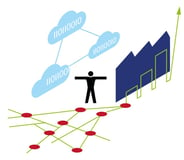5 Ways to Deliver Sustainability Success Now
Keith LaBotz - March 31, 2022
Transportation produces 29% of greenhouse gas emissions and your supply chain will have to reduce its share of this to Netzero by 2050. What does that mean for your supply chain, and why should you care?
Sustainability is a top priority for C-level business leaders, shareholders, customers. Regulators are also very excited about the new revenue opportunities.
- According to a recent study from Oxford Economics, nearly 90% of companies currently have or plan to update their purpose statement to prioritize sustainability.
- 68% of industrial business leaders indicated reduced energy consumption at their businesses in an SAP survey.
- Sustainability is a core value for Gen Z, who are willing to pay 10% more.
Promoting sustainability is easy and in return, a company can strengthen its brand reputation, build public trust, and position for future demand. Delivering on these commitments is another story - it’s not so easy. According to a McKinsey study, 70% of companies will fail. How can your company be part of the 30% that succeed?
The Goal is Not Sustainability - It’s Netzero
Sustainability is a buzzword with hundreds of definitions; successful sustainability initiatives need a measurable goal, and for that, we’ll use the most popular sustainability term, ‘Net Zero Emissions,’ or netzero.
Netzero is the point in time where humans stop adding greenhouse gases, GHG, to the atmosphere.
- Netzero achieves a balance between GHG emissions produced and removed from the atmosphere.
- It’s like a balance scale: producing greenhouse gas emissions tips the scale one way and cuts back emissions.
- Repairing past harm will mean reducing GHG emissions from burning carbon-based fuels.
- Supply chains produce GHG for energy production, sourcing raw materials, manufacturing, and logistics processes.
- Using lean principles to increase efficiency reduces consumption and emissions and increases profits.
Governments committed to a schedule that will reduce emissions to netzero by 2050 with the Paris Agreement in 2015. As more businesses continue committing to netzero goals, it’s only a matter of time until your company will, too, if it hasn’t already.
Green Logistics Delivers NetZero Emissions
Green logistics is the fastest, most profitable way to achieve netzero goals for many companies. Transportation is the most fragmented, inefficient link in the supply chain, and it's rich in cost and carbon savings. In short, the strategy is to minimize the miles driven results in less fuel burned, reduced carbon footprint, lower labor costs, less traffic congestion, reduced risk of traffic accidents, and lower maintenance expenses.
Distribution Site Selection
Optimal placement of distribution sites based on service level goals, profitability, and minimizing the number of miles driven for pickups and deliveries can significantly reduce GHG emissions. Fewer miles traveled means fewer tonnes of carbon, lower labor costs, lower risk of reduced maintenance.
Reducing Empty Miles
The biggest waste in road logistics is empty miles or unused capacity which refers to driving with empty trailer space. An estimated 15%-35% of all trips have empty miles. Examples of this are delivering a single pallet with a trailer that’s 80% empty or returning with an empty trailer after making a delivery.
Reducing empty miles reduces the number of trucks and traffic on the road. One company, Saint-Gobain, checks other divisions for shipments to fill trucks that are returning empty. Saint-Gobain is also able to look outside of its network and collaborate with other businesses on return legs. A collaboration with Heineken led to emissions reductions of 40% for those collaborative routes.
Vehicle Routing Optimization
Routing optimization minimizes the miles driven for vehicles in a transportation fleet. A dynamic routing solution like flexis ProfiTOUR, automatically creates pickup and delivery plans that minimize carbon footprint and maximize profitability.
- Route planning automation reduced labor costs by 60%.
- Delivery routes with multiple stops are optimized to minimize miles driven, reducing fuel expenses, GHG emissions, and driver labor.
- Routes ensure precise pickup and delivery windows are met, eliminating driver wait times reducing emissions and labor costs.
- Pickups can be mingled with delivery routes, maximizing equipment utilization and eliminating additional trips.
- ProfiTOUR’s routing algorithms consider the emissions profile for each vehicle in a fleet and the traffic patterns of each route.
When less efficient routes are taken, drivers spend more time in traffic and may have to quit driving to comply with HOS policies. Route drivers cannot make as many pickups and deliveries, so productivity is reduced while burning more fuel and increasing emissions.
Alternative Fuel Vehicles
The trucking industry is the biggest consumer of oil, accounting for about a quarter of global demand. Given that the world’s fleet of trucks is unlikely to shrink, this demand will only be reduced if alternative fuel sources are used. Barclays estimates that hydrogen-powered trucks could reach over 20% of the total fleet by 2050, from 0.3% today.
Source: Barclays Research
97% of trucks on the road are diesel and gasoline-powered. Replacing vehicles with electric and natural gas vehicles eliminates emissions. However, infrastructure for these vehicles is often limited outside of main transportation corridors and urban areas, limiting opportunities for metropolitan areas with charging and refueling stations. Over time, infrastructure may expand coverage to support the widespread use of vehicles powered by non-fossil fuels.
Measure the Carbon Footprint
The solutions will immediately reduce transportation costs and GHG emissions. The final piece of the puzzle is reporting on the results. Flexis Transportation Planning and ProfiTOUR can automate these processes, and they are already integrated with BigMile a carbon analytics solution. Using flexis solutions, your carbon footprint is automatically measured and reported to regulatory agencie's.
Conclusion
Transportation is a top source of GHG emissions, and it's also a top solution for Netzero goals. Green logistics offers the quickest, most profitable solutions for achieving sustainability initiatives.
Click below for more information on ProfiTOUR
LATEST POSTS
- Understand Circular Economy in The Manufacturing Industry
- How Can Industry 4.0 IT Integration Be Achieved Smoothly?
- The Significance of Order Sequencing in Discrete Manufacturing
- How to improve your Supply Chain Management: The Power of Control Towers
- Optimizing Human Resource Scheduling in Manufacturing: A Technological Approach


